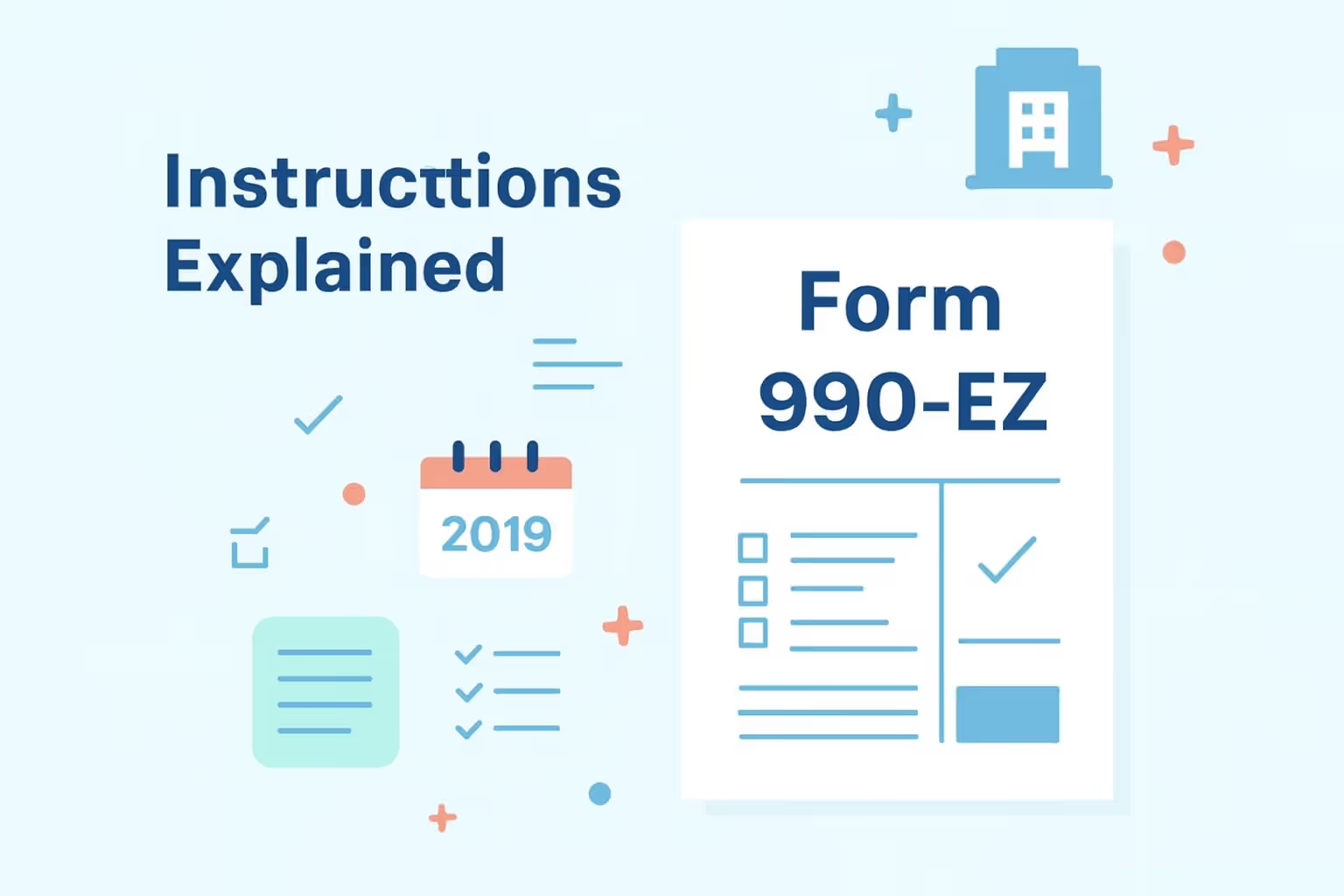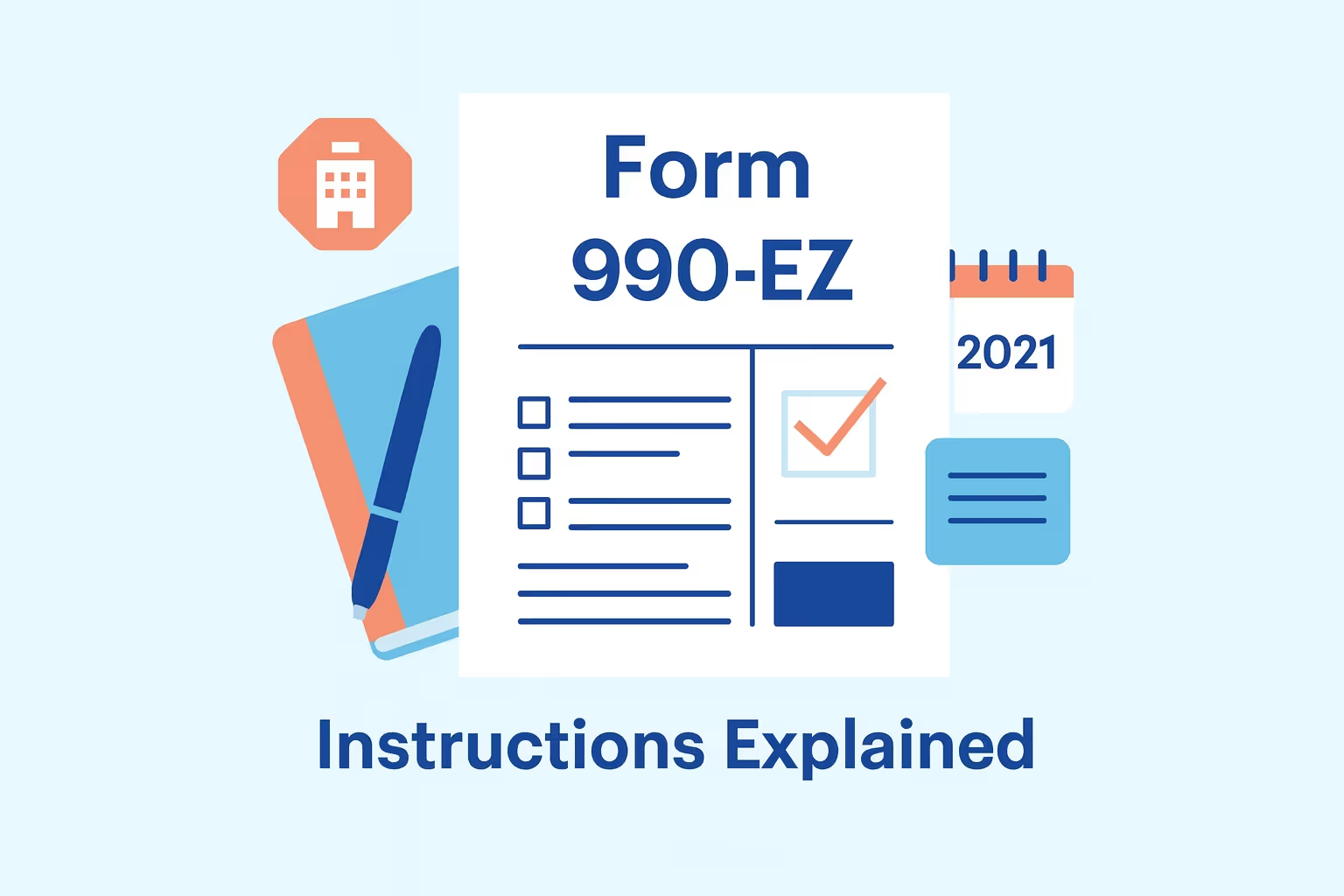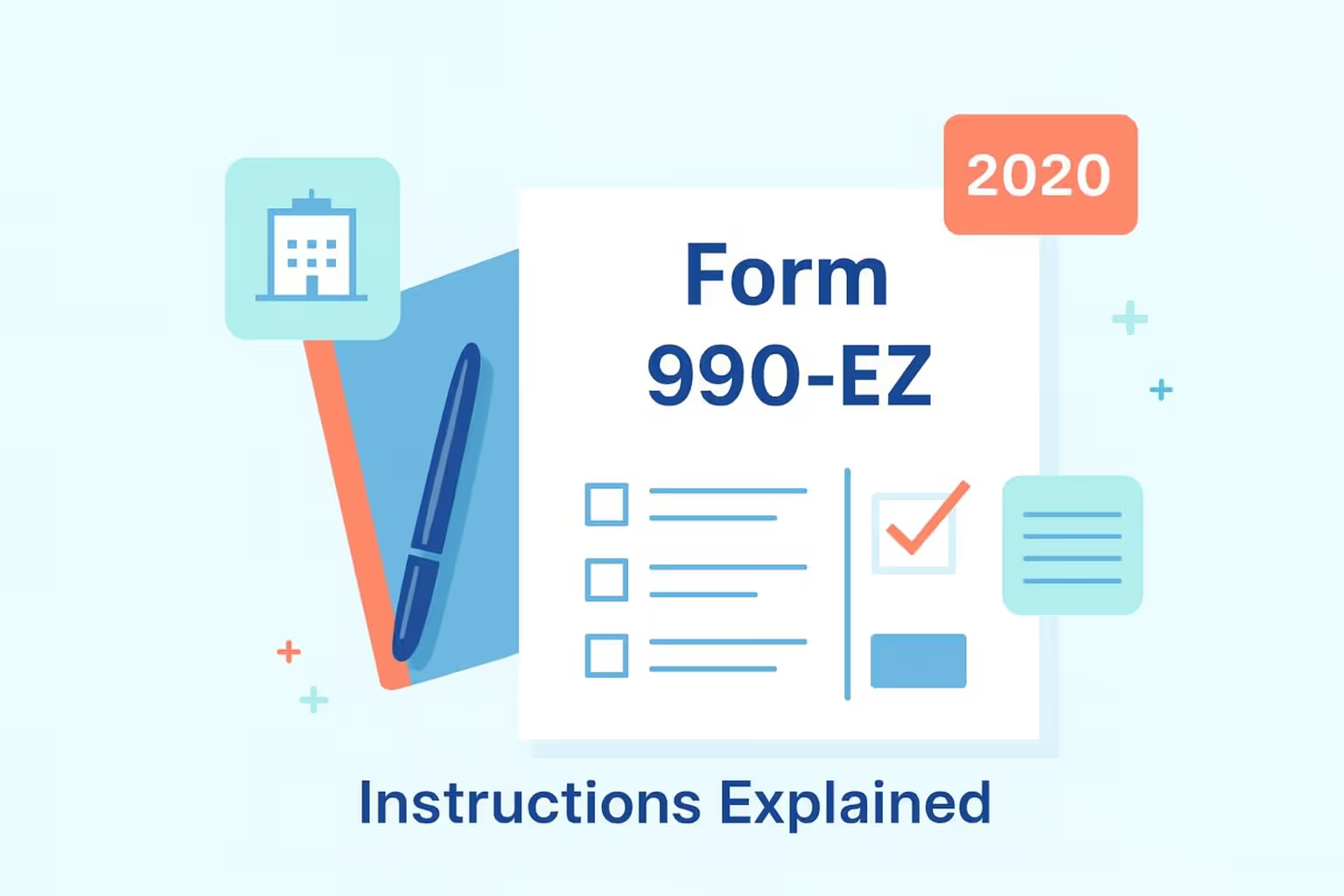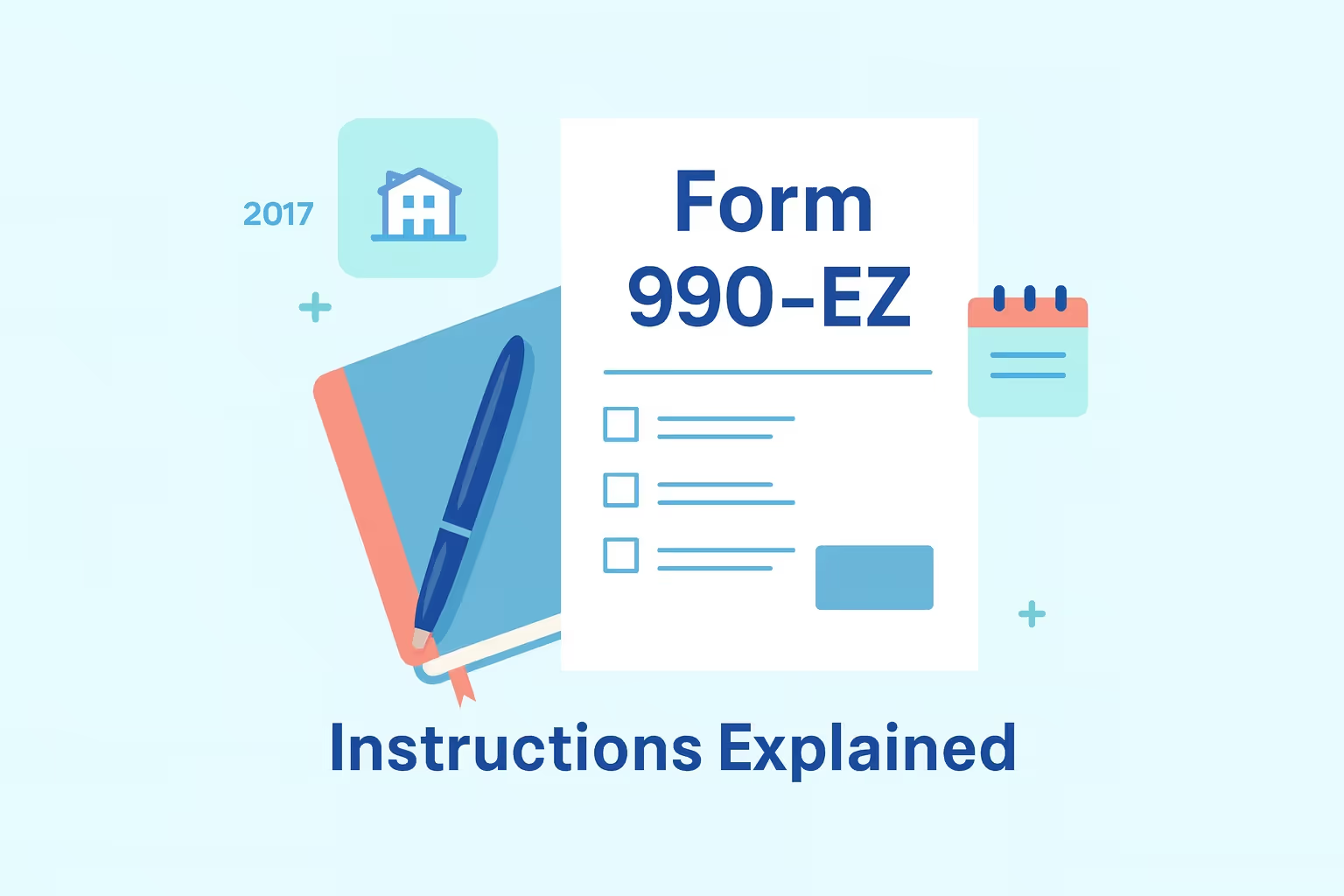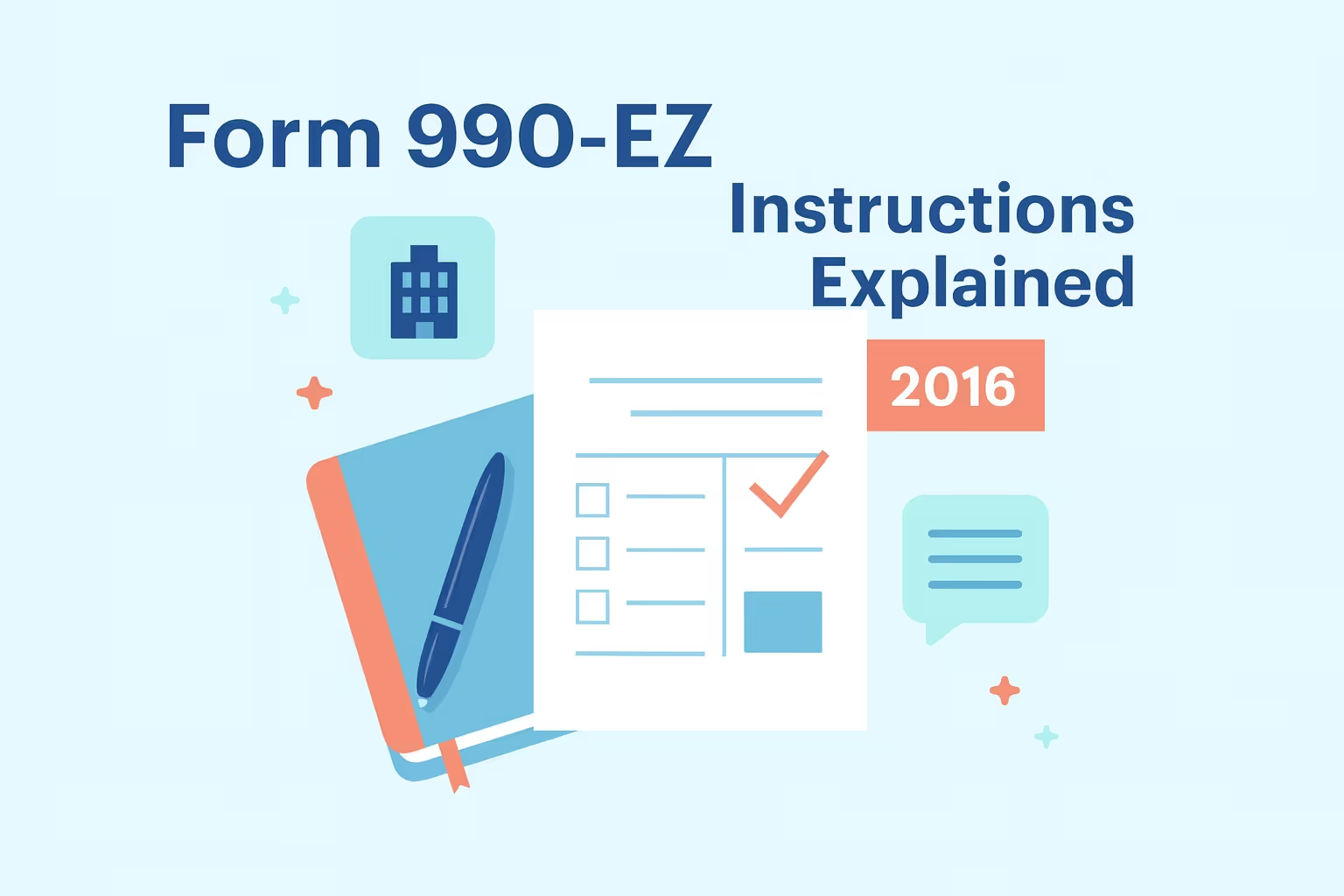Form 990-EZ 2014 Instructions: Complete Nonprofit Guide
Filing nonprofit tax returns requires careful attention and a clear understanding of federal income tax reporting under the Internal Revenue Code. IRS Form 990-EZ serves tax-exempt organizations that meet specific thresholds for gross receipts and total assets. Using this form helps nonprofits present financial statements, program activity, and net income in a concise format that supports transparency while meeting reporting requirements and providing accurate information to donors, regulators, and communities that rely on essential services.
The 2014 version applies to entities that operated during the calendar year or fiscal year in question. Eligible filers report an employer identification number, accounts payable, accounts receivable, fixed assets, and other assets, along with narrative explanations of mission results. Accurate totals help the public evaluate an organization’s financial health and overall governance practices. At the same time, consistent accounting methods prevent confusion when readers compare current figures with those from previous-year returns and supporting documentation across related activities and programs.
This guide explains how to gather records, align figures across sections, and complete each part so tax filings meet federal obligations. The About Form 990-EZ page on IRS.gov explains the form’s purpose, outlines basic eligibility, and links to prior-year documents that support preparation and data entry during the organization’s accounting period.
Eligibility to File Form 990-EZ
Organizations must confirm eligibility before filing Form 990-EZ to remain compliant with the Internal Revenue Code. This form is intended for tax-exempt organizations with modest financial health and straightforward reporting requirements. Verifying eligibility early helps nonprofit leaders align financial statements with accounting records and prevent submission errors.
Eligibility depends on an organization’s gross receipts, total assets, and financial activities. Nonprofits that qualify typically have simpler operations than those required to complete the full Form 990. Each filer must confirm that their organization’s accounting period and reporting data meet IRS standards.
Eligible filers benefit from accurate information reporting, which supports transparency and helps preserve tax-exempt status. These organizations must also maintain documentation that demonstrates consistency between their financial statements and other records. Proper verification ensures the return reflects reliable data and responsible financial management.
- Annual Gross Receipts: Must remain under $200,000 during the reporting period.
- Total Assets: Must be below $500,000 at the end of the calendar year or fiscal year.
- Organization Operated: Must serve public purposes under section 501(c) of the Internal Revenue Code.
- Private Foundations: Private foundations and disqualified person-controlled entities must use Form 990-PF.
- Related Organization: Entities linked through a group return or Schedule R must qualify independently.
- Accounting Requirements: Maintain accurate records, including accounts payable, accounts receivable, prepaid expenses, and fixed assets.
- Other Nonprofits: Other nonprofits, such as hospitals, schools, and health insurers, typically file the complete Form 990 due to expanded reporting requirements.
Verifying eligibility in advance saves time and ensures the organization uses the correct return. Each filer should confirm that their annual gross receipts and total assets match the IRS criteria. The IRS 2014 Instructions for Form 990-EZ (PDF) provides specific thresholds, examples, and clarifications.
A clear eligibility assessment builds trust with donors, regulators, and funding partners. Reviewing requirements before submission helps avoid rejection and reinforces accountability in nonprofit tax filings. Maintaining these standards also demonstrates the organization’s commitment to transparency and compliance.
Preparing Financial Information and the Balance Sheet
Accurate reporting begins with reliable financial data that reflects the organization’s financial health. Nonprofits preparing Form 990-EZ must gather detailed records that show revenue sources, expenses, and net income across all programs and activities. Each figure should align with financial statements to ensure consistent reporting and compliance with IRS standards.
The organization’s accounting period determines which data applies to the reporting year. Filers must include all transactions within the chosen calendar year or fiscal year. Any omission or misclassification may lead to discrepancies that affect the organization’s transparency and credibility with donors and regulators.
Records to Gather
Maintaining a complete set of financial records supports accurate tax filings and eligibility under the Internal Revenue Code. Each item listed should correspond to figures reported in Part I and Part II of Form 990-EZ.
- Revenue Sources: Include contributions, grants, program service revenue, and unrelated partnerships that generate income.
- Operating Expenses: Document salaries, program costs, and administrative expenses incurred during the year.
- Accounts Receivable: Record amounts owed for services or activities completed before year-end.
- Accounts Payable: List unpaid obligations due to vendors, contractors, or related organizations.
- Prepaid Expenses: Identify payments made in advance for future goods or services that benefit the next accounting period.
- Fixed Assets: Track long-term property, buildings, or equipment, noting market value adjustments when required.
- Other Assets: Include investments, inventory, or intellectual property relevant to the nonprofit’s operations.
- Total Liabilities: Combine all obligations, including loans, accrued expenses, and deferred revenue.
Each category should reconcile with the organization’s internal accounting system and external documentation. Consistency between internal records and the reported data strengthens confidence among stakeholders. Reviewing these items before submission ensures the nonprofit presents accurate information reflecting its operations.
Comparing current figures with those from the previous year helps identify trends or errors. Explain variations in total assets, total liabilities, or revenue patterns clearly in the supporting schedules. Clear documentation also simplifies audits and enhances understanding of the nonprofit’s activities over time.
Comprehensive preparation lays a solid foundation for accurately completing Part I and Part II. A well-organized financial record system supports timely filing and reduces errors during review. Careful attention to these details promotes accountability and demonstrates the organization’s commitment to compliance and transparency.
Program Service Accomplishments and Key Activities
Organizations must describe their mission and core programs in Part III of Form 990-EZ. This section outlines measurable outcomes that show how the organization operated to fulfill its exempt purpose. Transparent reporting helps donors understand program outcomes and ensures compliance with the requirements for tax-exempt organizations.
Each filer should include data that reflects tangible achievements. Reports may list the number of individuals served, grants distributed, or events held during the accounting period. Quantifiable outcomes strengthen public charity status and demonstrate alignment with the Internal Revenue Code.
The description should include ongoing and newly launched initiatives completed during the organization’s accounting period. Programs must directly support the nonprofit’s mission and show clear public benefits. Including examples with measurable data helps stakeholders evaluate overall performance.
- The organization provided emergency housing and meals to low-income families throughout the year.
- It hosted workshops on financial literacy, career development, and community education.
- The nonprofit awarded scholarships and educational grants to qualified recipients.
- It delivered health services, counseling, or awareness campaigns to underserved areas.
- The organization conducted research or advocacy on issues affecting local development.
- It operated volunteer programs designed to expand charitable outreach and increase impact.
Part IV addresses compensation and financial reporting for officers, directors, and key employees. The organization must list all reportable compensation, including deferred compensation and non-cash benefits, as required by law. Payments to independent contractors or related organizations also require disclosure when applicable.
Public support calculations confirm continued qualification as a public charity. Contributions, grants, and revenue counted toward support tests must be accurate and verifiable. Consistent reporting ensures accountability and reinforces the organization’s mission-focused activities.
Strong documentation of accomplishments highlights community impact and responsible management. Combine specific data with a clear summary of outcomes in each description. Maintaining accuracy throughout this section supports compliance, promotes donor confidence, and demonstrates measurable progress toward the organization’s exempt goals.
Governance, Management, and Public Disclosure
Sound governance ensures nonprofit organizations maintain compliance, accountability, and transparency in their operations. Form 990-EZ requires detailed reporting on how the organization managed oversight, financial responsibilities, and disclosure of public information during the accounting period. Each filer must demonstrate adherence to ethical standards that align with the Internal Revenue Code and protect public charity status.
Governance Requirements
- The organization must confirm that its accounting period matches the records used for financial statements and tax filings.
- The board of directors or governing body should actively oversee financial decisions, program implementation, and policy development.
- Meeting minutes, conflict-of-interest policies, and record-keeping systems must be kept up-to-date and readily accessible.
- Internal controls should safeguard assets, verify accounts payable and accounts receivable, and prevent unauthorized use of funds.
- Documentation of votes, approvals, and significant decisions must appear in board records for audit and compliance purposes.
- Leadership must verify that all reporting requirements under the Internal Revenue Code are met.
Disclosure Responsibilities
- The organization must make its Form 990-EZ and related schedules publicly available upon request.
- Copies of recent nonprofit tax returns should be accessible to donors, members, and regulatory agencies.
- Transparent reporting fosters donor confidence and enables stakeholders to assess the organization’s financial health.
- Reports involving intellectual property, unrelated partnerships, or investments must be reported on the appropriate schedules.
- Entities engaged in joint ventures or activities with a related organization must disclose relevant agreements and allocations of revenue that are material to their financial statements.
Required Schedules and Forms
- Schedule R: Used for reporting transactions or shared operations with a related organization or foreign entity.
- Schedule L: Discloses loans, grants, or transactions involving a disqualified person or insider.
- Schedule O: Provides space for narrative explanations of governance practices and additional details.
- Other Forms: This may include a group return or completion of Form 990 for complex organizational structures.
Effective governance and full disclosure reinforce accountability and compliance with federal reporting standards. Clear records and policies demonstrate the organization’s commitment to transparency and ethical management. Maintaining these practices supports continued tax exemption and strengthens trust among donors, regulators, and the public.
Form 990-EZ Due Date and Filing Options
Meeting Form 990-EZ deadlines is crucial for maintaining good standing with the IRS and preserving tax-exempt status. Organizations must identify their accounting period, select the correct submission method, and verify all required documents before submitting their tax return. A structured approach reduces errors, prevents delays, and supports accurate reporting of financial statements and organizational data.
Step 1: Confirm the Accounting Period
Determine whether the organization follows a calendar year that ends on December 31 or a fiscal year that ends on a different date. The chosen period determines which financial records, contributions, and annual gross receipts are applicable. Aligning the reporting window with the organization’s accounting system ensures accuracy across all tax filings.
Step 2: Identify the Correct Deadline
File Form 990-EZ on or before the 15th day of the fifth month after the accounting period ends.
- Calendar-year filers submit by May 15.
- Fiscal-year filers count five months from their closing date.
Missing this deadline may cause processing delays and impact the organization’s public charity status, so it is recommended to set reminders in advance.
Step 3: Request a Filing Extension
If more time is needed, file Form 8868 to request a six-month automatic extension. The request must be submitted before the original due date. Keep a copy of the confirmation for your records and ensure that other required tax obligations, such as unrelated tax filings, are completed on time.
Step 4: Choose a Filing Method
- Electronic Filing: Recommended for faster processing, error checking, and immediate acknowledgment.
- Paper Filing: Suitable for smaller organizations without e-file access, though mailing times may vary.
Each filer must use the same method consistently to maintain accurate IRS records.
Step 5: Prepare Supporting Documents
- Complete Form 990-EZ, filling out all parts.
- Attach applicable schedules (A, B, O, and others as required).
- Include financial statements reflecting total assets, liabilities, and net income.
- Include documentation supporting each reported figure.
Step 6: Verify Organizational Details
Check that the organization’s name, address, and employer identification number match IRS records. Discrepancies may delay acceptance or trigger correction requests. Accuracy in contact details also ensures future IRS correspondence reaches the right person.
Step 7: Submit and Retain Records
Submit the return by the due date and store both digital and paper copies. Maintaining prior-year filings supports audit readiness and continuity across fiscal periods. Maintain organized records to verify trends and confirm consistency across reporting years.
Timely submission and careful documentation reinforce accountability and compliance. Each completed step strengthens transparency and demonstrates reliable nonprofit governance. Consistent adherence to deadlines also enhances the organization’s reputation with donors and oversight agencies.
How to File Form 990-EZ Electronically
Electronic filing ensures efficient, accurate, and secure submission of Form 990-EZ. Using an authorized e-file provider helps nonprofit organizations maintain compliance, verify data, and receive prompt confirmation from the IRS. Each step supports accurate reporting and strengthens transparent financial management.
- Authorized E-File Provider: Organizations must choose an IRS-approved e-file vendor to submit Form 990-EZ. The platform’s system automatically checks for errors, reducing the risk of missing or inconsistent data. Selecting an approved provider ensures adherence to federal income tax reporting requirements.
- Account Setup: Create a secure account before beginning the return. Each user should have unique login credentials to protect sensitive information. Access should be limited to authorized staff or accounting professionals involved in tax filings.
- Data Preparation: Gather all financial statements, including total assets, total liabilities, accounts payable, and accounts receivable. Confirm that figures match the organization’s accounting method and reporting period. Include all revenue sources, such as contributions, grants, and program income, to present accurate information.
- Form Completion: Follow the step-by-step prompts within the e-file software. The system calculates totals automatically and cross-checks entries across parts for consistency. Reviewing each section ensures alignment with financial statements and supports compliance with reporting requirements.
- Attachment Uploads: Attach all applicable schedules and supporting documentation. Include Schedule A for public charity status, Schedule O for explanations, and other schedules as required. Each file must be unencrypted, clearly labeled, and consistent with data in the primary return.
- Validation and Review: Run the software’s built-in validation check to identify errors or missing information. Review and correct all flagged items before submission. Completing this process reduces the likelihood of rejection or delayed processing.
- Submission and Confirmation: Submit the finalized return through the authorized e-file system. The provider will generate an acknowledgment receipt once the IRS accepts the submission. Save both the confirmation and the full digital copy for future reference.
- Security and Record Retention: Store all electronic filings securely with access restricted to approved personnel. Keep digital records and acknowledgment receipts for at least three years to support audit readiness and maintain compliance with relevant regulations. Consistent recordkeeping supports transparency and improves accuracy in future filings.
E-filing offers a streamlined method for submitting nonprofit tax returns, promoting accuracy and compliance. Completing each step carefully ensures that the organization meets federal reporting standards and maintains its tax-exempt status.
Maintaining Exempt Status and Compliance
Nonprofits must actively maintain compliance with federal reporting requirements to preserve their tax-exempt status under the Internal Revenue Code. Consistent filing of Form 990-EZ or related returns demonstrates accountability and transparency. Organizations that fail to meet annual reporting requirements risk automatic revocation of their exempt status, which may disrupt operations and funding.
Maintaining eligibility requires careful recordkeeping, timely submissions, and accurate data reporting. Each filing must accurately reflect the organization’s financial health, mission-driven activities, and adherence to generally accepted accounting standards. Ongoing compliance safeguards public trust and helps ensure continuous recognition as a tax-exempt organization.
Annual Filing Requirements
Organizations must file a federal information return annually, regardless of their financial activity. The correct form depends on annual gross receipts and total assets. Selecting the correct version supports proper disclosure and reduces administrative delays.
- Form 990-N (e-Postcard): For organizations with annual gross receipts of normally $50,000 or less.
- Form 990-EZ: For entities with annual gross receipts under $200,000 and total assets below $500,000.
- Complete Form 990: For larger organizations exceeding both thresholds or requiring expanded disclosures.
- Form 990-PF: For private foundations subject to specialized reporting under the Internal Revenue Code.
Failure to file for three consecutive years results in automatic revocation of exempt status. Reinstatement requires a new application, payment of fees, and additional IRS review.
Recordkeeping and Documentation
Comprehensive records support transparency and audit readiness. Each organization must document financial transactions, governing board decisions, and donor communications. Strong internal controls and accurate bookkeeping promote consistency across reporting periods.
- Annual financial statements detailing revenue, expenses, and net income
- Bank records, grant agreements, and contribution receipts
- Meeting minutes reflecting board oversight and approval of significant actions.
- Payroll records, independent contractor agreements, and vendor invoices
- Property and asset records showing acquisition, depreciation, or disposal
Retaining these records for at least three years supports compliance with federal guidelines. Proper documentation supports accountability during reviews and strengthens public confidence in nonprofit governance.
Compliance Best Practices
Nonprofits should establish internal systems to monitor deadlines and confirm data accuracy. Regular reviews of policies, budgets, and activities help maintain alignment with exempt purposes. Staff training on reporting requirements promotes consistency and reduces the likelihood of errors in filing.
Guidance in IRS Publication 557: Tax-Exempt Status for Your Organization explains how entities qualify for and maintain exemption under section 501(c). This resource outlines operational standards, disclosure obligations, and the significance of timely reporting.
Proactive compliance safeguards organizational integrity and supports continued access to tax benefits. Maintaining accurate records, submitting timely filings, and following IRS guidance all contribute to long-term sustainability and public accountability.
Frequently Asked Questions
What qualifies exempt organizations to file Form 990-EZ?
Exempt organizations may file Form 990-EZ if they meet specific thresholds for gross receipts and total assets. The organization’s annual gross receipts must remain under $200,000, and total assets must stay below $500,000 at the end of the tax year. Filing this version helps smaller nonprofits demonstrate accountability and maintain tax-exempt status. Eligibility details and filing resources are available through the IRS website, which offers updated forms and guidance each year.
How should organizations calculate gross receipts for Form 990-EZ?
Gross receipts include all sources of revenue the organization receives during the tax year. This total covers contributions, grants, membership dues, and income from program services. Nonprofits must also include earnings from investments or unrelated partnerships, if applicable. Organizations must ensure consistent tracking of all reported revenue and expenses. Accurate reporting of gross receipts ensures compliance, reflects actual financial activity, and supports continued eligibility under federal tax exemption guidelines.
What happens when a nonprofit fails to file Form 990-EZ on time?
When a nonprofit fails to file for three consecutive years, the IRS automatically revokes its tax-exempt status. Losing exemption requires reapplication, fees, and additional review before reinstatement. Even a single late filing can create delays and affect grant eligibility. Organizations should maintain a compliance calendar, monitor deadlines, and confirm submission through the IRS website to ensure timely and accurate reporting. Timely reporting preserves recognition as a tax-exempt organization and reinforces trust among donors and partners.
Why is the employer identification number significant on Form 990-EZ?
An Employer Identification Number (EIN) identifies the organization in federal tax records. Every exempt organization must use this number consistently across filings, financial statements, and correspondence. Mismatched or missing identification details can delay processing or trigger compliance reviews. Using the correct employer identification number links the return to the appropriate entity. It ensures that all reported items, such as contributions, expenses, and net assets, are accurately recorded within IRS systems.
How are net assets reported in Part I of Form 990-EZ?
Net assets represent the difference between total assets and total liabilities. This figure shows the organization’s financial position at the start and end of the tax year. Accurate reporting of net assets demonstrates stewardship and supports continued tax exemption. Organizations should reconcile these amounts with financial statements to confirm accuracy. Clear presentation of net assets helps illustrate fiscal health and the proper use of funds received through contributions and program activities.
How should deferred compensation be disclosed on Form 990-EZ?
Deferred compensation must appear in Part IV under reportable compensation. This includes payments earned in one tax year but received in a future period. Proper reporting ensures compliance with federal rules governing exempt organizations. Each amount must match financial records and agreements with officers, directors, or key employees. Transparent reporting of deferred compensation maintains accountability and ensures that compensation practices align with charitable purposes and IRS disclosure requirements.
Where can organizations find current Form 990-EZ resources?
The IRS website provides official forms, filing tools, and eligibility resources for exempt organizations. Nonprofits can access prior-year versions, updated instructions, and e-filing resources specific to their tax year. The site also offers guidance on maintaining tax-exempt status, recordkeeping, and understanding gross receipts thresholds. Accessing the IRS website provides accurate information and helps organizations complete all required steps for timely and compliant nonprofit tax reporting.
















